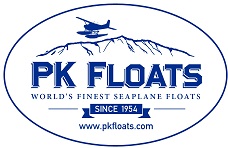PK 3000 Straight Float
The PK 3000 is a straight float that is the true workhorse of the PK Floats lineup. These floats weigh 442 lbs, measured on FAA approved scales. Once installed on the aircraft there is a net gain of approximately 312lbs, after subtracting the weight of original landing gear. If you are looking for robust, time-tested set of floats for your Cessna 180, please call us and find out if the PK 3000 is right for you.
FLOAT DESIGN
The PK 3000 features a robust full length keel that is nearly ½”x½” in cross section. This keel is so strong, that over half of the weight of the airplane can be supported on a single point forward of the step. There are also four hydroboosters forward of the step, which improve takeoff performance especially while on glassy water. This combination of keel and hydrobooster forward of the step create a very strong bottom structure. The internal bulkheads divide the float into watertight compartments. The main compartment, just ahead of the step can be accessed through out flush hatch and utilized for storage.
CORROSION PROTECTION
Prior to assembly, all aluminum components, including skins and bulkheads, are chemically treated and then epoxy primed. During assembly, the floats are fully sealed to create a watertight structure. All dissimilar metals are isolated to prevent corrosion. Following assembly, the exterior of the floats are cleaned and painted with two coats of aluminum pigmented lacquer or color matched to the plane with urethane paint.
MAINTENANCE & REPAIR
The PK 3000 float is manufactured using flat sheet aluminum, there are no specially formed bottoms, or stamped bulkheads. Therefore skins can easily be replaced in the event of severe damage. This also means that in the event of an emergency, field repairs can be made with ordinary hand tools.
PERFORMANCE
The basic hydrodynamic configuration of the float is a deep-V variable deadrise design. What makes the variable deadrise hull unique is how is behaves while on takeoff. As the float accelerates, it rises out of the water, and as it rises out of the water, drag is reduced. The reduced drag results in faster acceleration, and the floats rise even higher in the water. This chain of events is repeated until flying speed is obtained. The high sternpost angle permits small radius turns and freedom during aircraft rotation at takeoff. Rough water operations are unsurpassed because of the deep-V design of the bottom. Takeoff distance on glassy water is reduced, because of the addition of four hydroboosters, even in high density altitude conditions.
- Cessna 180, Cessna 185
- Max Gross Weight: 3352lbs
- Displacement of one float completely submerged: 3017lbs
- Max Stalling Speed: 62mph
- Hull Length, width, depth: 229.9”, 31.4”, 27.3”
- Keel to Keel: 100.5”
- Overall Width: 132”
- Cruise Speed: 112kts (C-180), 115kts (C-185)
- Installed Weight: 424lbs
- Height (Top of tail): 150”
- Baggage Compartment: Standard, 100lbs max
- Number of Watertight compartments: 7






